#Brederode
Text

Flagship Brederode, detail from the painting "The Battle of Terheide" by Jan Abrahamsz Beerstraaten (1622-1666)
347 notes
·
View notes
Text
Historische huizen omgeving Haarlem

Het eerste huis waar een kijkje nemen is Huis Zanen aan de Orionweg 1 in Haarlem.
Zaanen was oorspronkelijk een heerlijkheid in de omgeving van Haarlem. In 1296 werd het zich hier bevindende kasteel verwoest uit wraak omdat Willem Zaanen deel uitmaakte van het complot van edelen om Floris V te vermoorden.
Op 12 december 1572 werd het herbouwde kasteel door de Spaanse troepen in bezit genomen ten behoeve van het beleg van de stad Haarlem. Nadat de bewoners van Haarlem de strijd door honger moesten opgeven, namen de Spanjaarden de stad in en werd het Huis te Zaanen opnieuw verwoest.
In een lijstje van goederen die in leen gehouden werden van de graven van Holland, dat gedateerd moet worden tussen 1316-1321 vinden we Simon van Zaenden, hoogstwaarschijnlijk een van de zoons van Willem van Zaenden, met zogenaamde leen van het huis te Zaanen.
Het huis wordt omschreven als 'die woninge ende dat hele land liggende tussen Hendrik van Brederode's land en jonkvrouw Kerstine (van Schoten)', aan de westzijde belend door de halve Veenweg en aan de oostzijde door het Spaarne'.
Op 19 februari 1325 maakt hij deze woning tot lijftocht voor zijn vrouw Femence (of Semence). Nu wordt ervan gezegd, dat het huis in Schoten staat.
In 1881 kocht de heer A.A. Bredius, directeur van de buskruitfabriek “Muiden” het “Huis te Zaanen” voor 53.500 gulden voor zijn zoon C.J.A. Bredius. Het landgoed met de boomgaarden strekte zich uit van de Delft een beek die liep tot aan de Rijksstraatweg. Het landgoed stond bekend als “de tuinen van Bredius”.

Willem Gunzeln: “De heer Bredius verkocht zijn landgoed aan de gemeente Schoten, onder de voorwaarde, dat het een nuttige, educatieve bestemming zou krijgen. Aan die voorwaarde wordt nog steeds voldaan. Want tegenwoordig wordt de begane grond van Huis te Zaanen vooral gebruikt als vergaderlocatie en worden er trainingen en workshops gegeven. Daarnaast worden er ook regelmatig informatie- en voorlichtingsbijeenkomsten voor de omwonenden gehouden”.
Vele Haarlemmers bewaren dierbare herinneringen aan Huis te Zaanen, dat van 1930 tot 1988 dienst deed als bibliotheek.
Mogelijk functioneerde het huidige gebouw als een poortgebouw dat toegang gaf tot een erachter gelegen voormalig kasteel van de heerlijkheid te Zaanen. Een tijdlang is het Huis omringd geweest door een slotgracht.
Dat het gebouw, zoals het er nu staat, in niets meer herinnert aan het oude kasteel, is duidelijk te zien. Er is van het oude kasteel voor zover wij weten geen afbeelding bewaard gebleven. Wel zijn er toevallige vondsten bekend, o.a. van kloostermoppen die er op kunnen wijzen dat het 13e -eeuwse kasteel daar gestaan heeft. Voor de rest zijn er kannetjes, munten etc. gevonden. Een beetje vreemd doet het aan, dat er op het einde van de 18e eeuw sarcofagen voor de dag kwamen, zoals Adriaan Loosjes in zijn 'Hollands Arcadia' (1804) vermeldt. Er zou dan bij het kasteel een kerk of kapel met begraafrecht geweest moeten zijn, tenzij deze relicten uit het verleden van elders afkomstig waren.

We gaan nu verder in Haarlem en komen uit bij Huis ter Kleef. Ook dit is een voormalig Nederlands kasteel, dat dateerde uit de dertiende eeuw. De ruïne van het kasteel ligt in de huidige Haarlemmer Kweektuin.
Huis ter Kleef werd gebouwd in 1250 en heette destijds 'Huis te Schoten'. Het kasteel lag aan een drukke verbindingsweg tussen Haarlem en het dorp Schoten (ten noorden van Haarlem). In eerste instantie stond er alleen een woontoren die in het bezit was van Pieter van Rolland.
Na hem was het kasteel in bezit van Willem de Bastaard en Willem de Duser (1339 - ±1370), Willem Cuser (junior) (± 1365-1392), Catharine de Cleve (1392-1433) en de familie Van Borsselen (vanaf 1433-?).

Zij veranderden de naam van 'Huis te Schoten' naar 'Huis ter Kleef'. De hierna volgende eigenaren zijn: de familie Brederode (1492-1568) en Don Frederik (1570-1573).
Don Fadrique Álvarez de Toledo (21 september 1537 – 11 december 1585), hertog van Huescar en 4e hertog van Alva, doorgaans aangeduid als Don Frederik, was een Spaans bevelhebber van de infanterie ten tijde van het begin van de Tachtigjarige Oorlog. Hij is vooral bekend als leider van de troepen tijdens de veroveringen van Mechelen, Zutphen, Naarden en Haarlem. Ook was hij aanvoerder van de Spaanse troepen tijdens het beleg van Alkmaar.
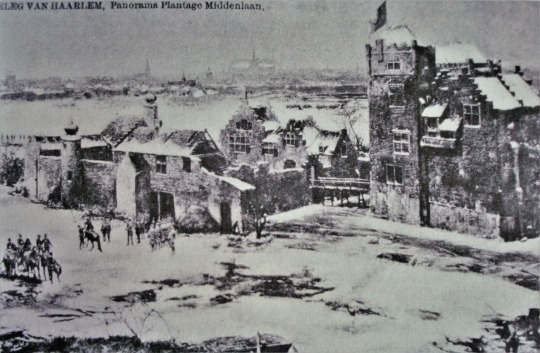
Het kasteel was in 1572 en 1573 het hoofdkwartier van de Spanjaarden tijdens het Beleg van Haarlem. In 1573 werd Huis ter Kleef opgeblazen door Don Frederik (de zoon van de hertog van Alva). Dit deed hij om te voorkomen dat de Geuzen zich in het kasteel zouden vestigen om Haarlem te heroveren.
Nadat het kasteel in 1573 was opgeblazen door Don Frederik sloopten de Haarlemmers in 1576 een deel van de ruïne om de bakstenen te gebruiken voor het herstel van de stad na de grote brand in Haarlem van 1576.
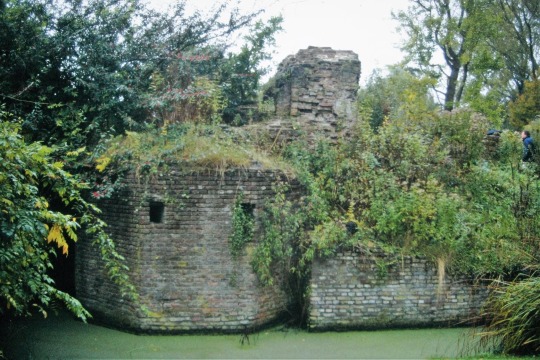
In 1578 kwam Huis ter Kleef weer in handen van de familie Van Brederode. Zij besloten de ruïne niet meer op te bouwen en alleen de Kaatsbaan (of het 'Huis met het torentje'), dat niet was opgeblazen, te gebruiken.
Omdat de opvolging binnen de familie Van Brederode een probleem vormde, werd in 1600 het erfrecht van de familie omgezet in 'sterfelijk mansleen'. Ook zusters, dochters en kleinkinderen konden het kasteel nu erven.
Middels een huwelijk met de familie Dohma kwam Huis ter Kleef in handen van de Duitse graaf Frederik Adolf van Lippe. Het land om de ruïne van het kasteel gaf weinig opbrengst en de schulden van het landgoed liepen hoog op.
In 1713 had Von Lippe zoveel schulden dat hij een deel van zijn bezittingen moest afstaan, waaronder Huis ter Kleef. De ruïne en het land eromheen werden door de stad Haarlem gekocht. Vanaf die tijd brokkelde de ruïne in snel tempo af. De Haarlemmers gebruikten de stenen voor het bouwen van nieuwe huizen.

Sinds 14 april 1909 liggen de ruïne en Kaatsbaan in de Stadskweektuin. Slechts een klein deel van de ruïne is nu nog zichtbaar, de rest ligt onder het zand van het eilandje waar de ruïne op staat.
De eigenaren van Huis ter Kleef
Pieter van Rolland
Willem de Bastaard
Willem de Cuser
Willem de Cuser (junior)
Catharine de Cleve
Familie Van Borssele (vanaf 1433)
Familie Brederode (1492-1568)
Don Frederik (1570-1573).
Huis te Aelbrechtsberg in Bloemendaal is niet meer terug te vinden, maar desondanks wil ik u er over vertellen over de historische betekenis.
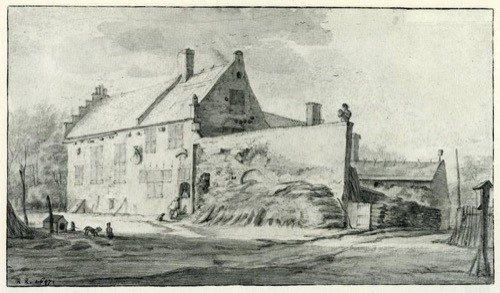
Het voormalige huis werd ook wel als volgt genoemd: Huys te Blommendael of Aelbertsbergh of Aelberberg of Albertsberg.
De etymologie zegt dat het genoemd is naar St. Adelbert, de apostel van Kennemerland.
Het huis Aelbrechtsberg fungeerde als een bestuurscentrum voor de graaf van Holland. Tal van oorkonden werden er binnen de muren van Aelbrechtsberg opgesteld. De Rooms-koning Willem (graaf Willem II) ontving daar ondermeer een deputatie van de stad Utrecht op 21 juni 1255.
Ook graaf Floris V was, volgens de historie, veelvuldig op het slot aanwezig.
In 1333 kwam het in bezit van Hendrik van Brederode. Het kasteel raakte echter in de 14e eeuw in verval. Wel werd het in 1502 nog bewoond. Of het huis deels of volledig herbouwd was, is onduidelijk.
In 1558 werd het lege huis betrokken 'door scamele luijden' om daar een brouwerij in te beginnen.
In 1617 waren er 3 eigenaars en werd het omschreven als 'het huijs te Bloemendaal met de twee boomgaarden, het visrijke meer, zijn singelen en nog een cooltuijntje'.
In 1627 was Lukas van Valkenburg de eigenaar. Na 1658 werd er een nieuw huis neergezet.
In 1813 werd het inmiddels vervallen huis (zoals gebruikelijk was in die tijd) voor de sloop verkocht.
25-2-2023
1 note
·
View note
Video
youtube
Ruins and Remains
3 notes
·
View notes
Text
Wonderkid Factory | Part 4 | Hammering Real Madrid
#FM24 #WonderkidFactory Part 4: Hammering Real Madrid. The homegrown project at @AZAlkmaar continues to impress as they claim a huge scalp in the #ChampionsLeague. And their exciting youngsters push Ajax all the way in #Eredivisie.
Read here:
Footballing overachievement is seemingly always accompanied by the threat of your best players being poached by bigger clubs. And Robinho Lazaró found that out in the summer of 2025 as his AZ Alkmaar’s 2nd place finish in Eredivisie saw big teams across Europe raise interest in his top performers.
That included the likes of Myron von Brederode, who wanted to move to a bigger club and Lazaró…

View On WordPress
#AZ#AZ Alkmaar#Christian Moestrup#Dawid Imiela#Denso Kasius#Enoch Mastoras#FM24#Football Manager#Football Manager 2024#Football Manager 24#Jasper Hartog#Jayden Addai#Lewis Schouten#Manuel Piqué#Mees de Wit#Myron van Brederode#Raily Wau#Robinho Lazaró#Rome-Jayden Owusu-Oduro#Tómas Johannessen#Wessel van Dord#Yoël van den Ban
0 notes
Photo

Nelson Brederode – A Charada Sincopada
https://cenaindie.com/album/nelson-brederode-a-charada-sincopada/
0 notes
Link
Op zaterdag 3 december bezoekt Sinterklaas met 2 Kleurpieten speeltuin Kindervreugd. Circa 50 kinderen tussen 3 en 9 jaar worden verblijd met cadeaus, die beschikbaar zijn gesteld door Rotaryclub Santpoort-Brederode. Het is de derde keer dat Sinterklaas de kinderen uit Haarlem-Oost bezoekt. In samenwerking met Haarlem Effect, DOCK Haarlem, CJG, Speeltuin Kindervreugd en Rotaryclub Santpoort-Brederode worden 50 kinderen blij gemaakt met een woordje van de Sint en een passend cadeau voor elk kind, tijdens een feestelijke ochtend op zaterdag 3 december tussen 11 en 13 uur. Dit feest is speciaal voor kinderen die vanuit thuis niet de kans hebben om verrast te worden met een cadeau en een echt Sintfeest. Rotaryclubs stellen jaarlijks geld beschikbaar en bieden hand- en spandiensten aan maatschappelijke instellingen. Dit wordt nu de derde keer dat dit feest kan plaatsvinden dankzij, de steun en begeleiding van Rotary en Dock. Programma Datum: zaterdag 3 december 2022, locatie Speeltuin Kindervreugd, Godfried van Bouillonstraat 70 Haarlem Tijd: 11.00-13.00 uur Leeftijd:3-9 jaar. Sinterklaas komt binnen om 11.00 met Kleur Pieten De kinderen worden in groepjes verdeeld van 10 kinderen per keer ( evt. met ouders verzorgers ) 3-5 kinderen komen per keer bij Sinterklaas daar heeft de Sint kleine gesprekjes met de kinderen. Pieten vermaken de kinderen met hun dansjes en gekke kunstjes.
0 notes
Text
"Carnet Imaginaire" [Celano / Badenhorst / Baggiani feat. Wolfert Brederode: Carnet Imaginaire (Challenge Records. 2022)] Por Pachi Tapiz. JazzX5 #544 [Minipodcast de jazz]
“Carnet Imaginaire” [Celano / Badenhorst / Baggiani feat. Wolfert Brederode: Carnet Imaginaire (Challenge Records. 2022)] Por Pachi Tapiz. JazzX5 #544 [Minipodcast de jazz]
“Carnet Imaginaire”
Celano – Badenhorst – Baggiani feat. Wolfert Brederode Carnet Imaginaire (Challenge Records. 2022)
Tomajazz: © Pachi Tapiz, 2022
Escuchar Celano / Badenhorst / Baggiani feat. Wolfert Brederode Carnet Imaginaire: “Carnet Imaginaire”
En anteriores episodios de JazzX5 / HDO / LODLMA / Maltidos Jazztardos / Tomajazz Remembers /JazzX5 Centennial / Universos…

View On WordPress
#Celano / Badenhorst / Baggiani feat. Wolfert Brederode#Challenge Records#Guillermo Celano#JazzX5#Joachim Badenhorst#Marco Baggiani#Minipodcast de jazz#Pachi Tapiz#podcast de jazz#Wolfert Brederode
0 notes
Text


The Life of Joan of Arc – Jules-Eugène Lenepveu // Louis XIV at the Taking of Besancon – Adam Frans van der Meulen // William III of England – Jan Wyck // Infant-Cardinal Don Fernando of Austria on Horseback – Gaspar de Crayer // Portrait of Johan Wolphert van Brederode – School of Thomas de Keyser // Equestrian Portrait of Philippe de France – Pierre Mignard // Karl XI, King of Sweden – David Klöcker Ehrenstrahl // Equestrian Portrait of Louis XIV – René-Antoine Houasse // Equestrian Portrait of Charles XI of Sweden – David Klöcker Ehrenstrahl // Herzog Karl V. von Lothringen – unknown artist // King Charles XI of Sweden Riding a Horse – David Klöcker Ehrenstrahl // Louis-Philippe, Duc d’Orleans, Saluting His Army on the Battlefield – Alexander Roslin // Equestrian Portrait of Philip IV – Diego Velázquez // Jérôme Bonaparte, King of Westphalia – Antoine-Jean Gros // Equestrian Portrait of King George II – Joseph Highmore // Equestrian Portrait of William II, Prince of Orange – Anselm van Hulle // Equestrian Portrait of King William III – Jan Wyck // Guy On A Horse – Maisie Peters
#as soon as i heard maisie reference joan of arc you know i had to make an edit for it#also i heard this song and immediately thought “lmao all those thousands of equestrian portraits”#they truly are all just a guy on a horse#joan of arc#jeanne d'arc#saint joan of arc#equestrian portrait#equestrian portraiture#guy on a horse#the good witch#the good witch maisie peters#maisie peters the good witch#tgw maisie peters#tgw#maisie peters tgw#the good witch deluxe#maisie peters#art#art history#lyrics#lyric art
108 notes
·
View notes
Text
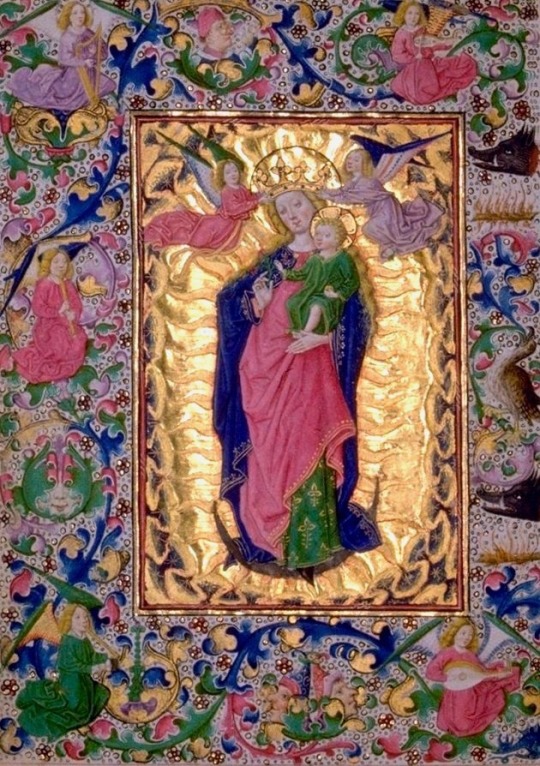
Madonna from a Book of Hours by Gysbrecht de Brederode ca. 1470
8 notes
·
View notes
Text

'Portrait of Reinoud III of Brederode' as painted in 1545 by Jan van Scorel (1495-1562).
7 notes
·
View notes
Text

The Brederode flagship of Maarten Tromp in 1652/53, by Maarten Platje (1967-)
86 notes
·
View notes
Text
Happy Birthday to...

Sophie von der Pfalz, Electress of Hannover, and James VII and II, born on 14 October 1630 and 1633 respectively.
James and Sophie remained in lifelong contact, and the exiled James considered her one of his few allies.
...Little did he know that Sophie was close with both William and Mary, growing particularly fond of the latter in an almost maternal capacity.
Sophie- the woman who would almost have been Queen of England twice
Originally a candidate for marrying James' brother, the recently restored Charles II, the latter settled for Catherine of Braganza instead.
Rather than as consort, Sophie later would almost have become Queen in her own right when the Act of Settlement, implemented by William III, named her as heir presumptive to the crown.
When Sophie visited The Hague with her little niece Liselotte in the winter of 1659/1660, little did she know that one day, the nine-year-old William of Nassau who romped through the Binnenhof palace with her niece would become King of England, and declare her the heir presumptive to the throne. At the time, Sophie was heavily pregnant with her son Georg Ludwig, the future George I who became King of Great Britain when Queen Anne died in 1714. Sophie, alas, had predeceased the much younger Anne by a mere handful of weeks.
Sophie on her own birthday:
In 1680, the year she turned fifty, Sophie decided to write her own memoirs, including a description of her birth and early years. Here is what she had to say on the circumstances of her birth:
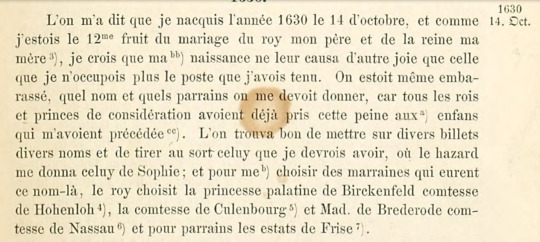
Sophie, Electress of Hannover and Köcher, Adolf [Ed]: Memoiren der Herzogin Sophie nachmals Kurfürstin von Hannover, Leipzig 1879, p. 33.
They told me that I was born in the year 1630 on the 14th of October, and since I was the 12th fruit of the marriage of the King my father and the Queen my mother, I think that my birth did not cause them any other joy than that of my no longer occupying the place I previously did. They were even at a loss which name and which godparents one should give me, as all the kings and princes to be considered had already taken this trouble for the children who had preceded me. It had pleased them to put various names on slips of paper and to draw from them the name I was to receive, and chance gave me that of Sophie; and to choose godmothers for me who had that name, the King picked the Princess Palatine of Birkenfeld, Countess of Hohenlohe, the Countess of Cuylenburg and Madame de Brederode, Countess of Nassau, and as godfathers the states of Frisia.
Happy birthday, Sophie von Hannover! She may have been the 12th child of her parents, but she left us first-rate sources in the shape of her memoirs and parts of her correspondence, providing a window into 17th century life and politics.
#sophie von hannover#james ii#17th century#history#on this day#otd#the stuarts#house of stuart#stuartposting
46 notes
·
View notes
Text
La Fayette in Vianen
I stumbled over a very interesting Dutch article titled “La Fayette en Vianen” the other day and decided to do some research. I always wanted to know where exactly La Fayette and his family stayed while they lived in exile in Vianen (modern day Netherlands). Since most books brush over the family’s time in the Dutch village, I had to do my own digging.
First, a little run-down. After being released from the prison in Olmütz, La Fayette, Adrienne and their daughters settled in Wittmold and Lehmkuhlen in the neutral Danish-Holstein (modern day Germany.) Adrienne’s aunt Madame de Tessé had rented the Gut Wittmold and the region was a place many exiles choose to settlein. It was here that the La Fayette’s were reunited with their son and brother Georges who had spent the last years in America. La Fayette’s oldest living daughter Anastasie married while in Wittmold but tensions rose with time. Adrienne returned with her daughter Virginie to France to regain some of the family’s fortune. Anastasie, now pregnant, and her husband went to Vianen and settled there. Their twin daughters would be born and baptized there. The archive in Utrecht holds the baptism record. Adrienne meanwhile managed to obtain a passport that allowed La Fayette to travel to Vianen as well. The whole family was again reunited in Vianen in 1799.
Vianen was at that point in time part of the Batavian Republic. The Batavian Republic was the successor of the Republic of the Seven Netherlands/United Provinces of the Netherlands. Its formation on January 19, 1795 was heavily influenced by French revolutionary troops but the reform of government was desired by the Dutch people. The Republic became the Dutch Commonwealth in 1801 and was later abolished on June 5, 1806 when Napoléon’s brother Louis Bonaparte was crowned King of Holland. The Batavian Republic was the first of Frances “sister-republics” and later part of the French Empire. The Batavian Republic was organized in different Departments. This map from 1798 shows the order La Fayette would have found in 1799. Utrecht is located in the North-east of the Department van de Rijn:

Utrecht would become its own department in 1801:

With that all being said, we can move on to La Fayette’s address. He lived in the county house (buitenplaats) Buitenlust (I have a hard time finding a suitable English translation, but buitenlust describes the joy of the outdoors) in the Prinses Julianastraat. (princess Juliana street) The house was erected in 1770 for Jacob Cambier and demolished in 1901. Buitenlust was composed of two stories on a rectangular piece of land. A picture of Buitenlust adorns an old postcard from Vianen.
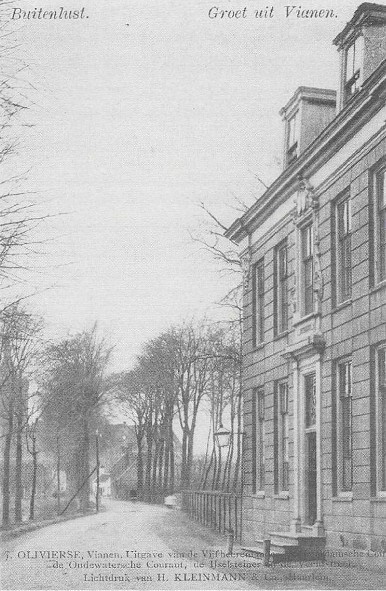
Piet de Hertog, De Prinses Julianastraat, geschiedenis en verdwenen verbouwing, in Het Land Van Brederode – Jaarboek 2013, 2013, pp. 16-25.
After Cambier’s death in 1783, the ownership passed to his son Joan Jacob Cambier. It was he who rented the house to La Fayette and his family.
While the neighborhood has severely changed over the last decades, there is still something left of the original Buitenlust. In 1939 a new building, a single family home, was erected on the grounds of the old country house. The house has a gable stone marked with the word “Buitenlust". The address today is Prinses Juliananstraat 26 in Vianen.



La Fayette’s connecttion with Vianen, Buitenlust and the Cambier family was further explored in the article De Prinses Julianastraat, geschiedenis en verdwenen verbouwing, published by the historical society Het Land Van Brederode:
De bouwheer van Buitenlust was Jacob III Cambier (1711-1783), éen van de Viaanse vooraanstaande Patriotten. Jacobs contacten met de Fransen leidden er tie dat de bekende politicus en generaal Gilbert du Motier, markies De Lafayette (1757-1834) op Buitenlust onderdak vond. Lafayette kende een turbulente politieke carrière en mocht na zijn vrijlating uit oostenrijikde gevangenschap niet naar frankrijk terugkeren. De markies werd vooral bekend door zijn strijd tegen de Englesen in de Amerikaanse vrijheidsoorlog. De deatilas en de betrouwbaarheid van zijn verblijf in Vianen zijn niet exact bekend, maar he is een feit dat De Lafayette in 1799 in Vianen verbleef. Dat volgt namelijk uit een brief die hij vanuit Vianen schreef aan George Washingon. Van de eigenaarsgeschiedenis van Buitenlust zijn slechts flarden bekend. De laaste bewonder van Buitenlust was Willem Jacob II Cambier (1844-1901), secretaris penningmeester van het hoogheermraadschap de of. Na zijn overlijden werd het huis nog in datzelfde jaar abgebroken.
Piet de Hertog, De Prinses Julianastraat, geschiedenis en verdwenen verbouwing, in Het Land Van Brederode – Jaarboek 2013, 2013, pp. 16-25.
My translation:
The builder of Buitenlust was Jacob III Cambier (1711-1783), one of Vianen’s foremost patriots. Jacob’s contact with the French lead to the prominent politician and General Gilbert du Motier, marquis De Lafayette (1757-1834) finding shelter in Buitenlust. Lafayette’s political career had been turbulent, and he was not allowed to return to France after his release from Austrian imprisonment. The marquis was most famous for his fight against England in the American War of Independent. The details of Lafayette’s stay in Vianen are not completely certain, but it is known that he was in Vianen in 1799. This is primarily proven by a letter that he had send to George Washington from Vianen.
The last resident of Buitenlust was Willem Jacob II Cambier (1844-1901), secretary of the treasury for the council of Vijfheerenlanden [a municipality in the province of Utrecht.] After his death, the house was demolished the same year.
The article is wrong in one aspect; there is more than one letter to prove that La Fayette was in Vianen. There is one letter to Thomas Jefferson from April 19, 1799 and one to George Washington from May 9, 1799. Then there is also the letter from Wiliam Vans Murray to John Quincy Adams from March 19, 1799. Murray had visited La Fayette and his family in Vianen and was fairly shocked by what he witnessed there. We furthermore have several legal documents in the archive in Utrecht as well as this except from Virginie’s book:
After a short stay there [Paris], and a visit to Mme de Chavaniac in Auvergne, we all met again in the following year (1799) at Vianen, near Utrecht. My father had come there from Holstein, with George. Exiles can fix themselves nowhere. Their only thought is to abandon their momentary home, their only wish, to depart. It was there that my sister gave birth to her first child, and that my aunts came to see us.
Mme de Lasteyrie, Life of Madame de Lafayette, L. Techener, London, 1872, p. 377.
#la fayette in exile#la fayette#adrienne de lafayette#adrienne de noailles#virginie de lafayette#anastasie de lafayette#georges de lafayette#french history#french revolution#american history#founders online#letters#1799#vianen#utrecht#batavian republic#wittmoldt#thomas jefferson#george washington#john quincy adams#wiliam vans murray#history#marquis de lafayette#buitenlust#google maps
20 notes
·
View notes
Text
Events 4.5
823 – Lothair I is crowned King of Italy by Pope Paschal I.
919 – The second Fatimid invasion of Egypt begins, when the Fatimid heir-apparent, al-Qa'im bi-Amr Allah, sets out from Raqqada at the head of his army.
1242 – During the Battle on the Ice of Lake Peipus, Russian forces, led by Alexander Nevsky, rebuff an invasion attempt by the Teutonic Knights.
1536 – Charles V makes a Royal Entry into Rome, demolishing a swath of the city to re-enact a Roman triumph.
1566 – Two hundred Dutch noblemen, led by Hendrick van Brederode, force themselves into the presence of Margaret of Parma and present the Petition of Compromise, denouncing the Spanish Inquisition in the Seventeen Provinces.
1614 – In Virginia, Native American Pocahontas marries English colonist John Rolfe.
1621 – The Mayflower sets sail from Plymouth, Massachusetts on a return trip to England.
1792 – United States President George Washington exercises his authority to veto a bill, the first time this power is used in the United States.
1795 – Peace of Basel between France and Prussia is made.
1818 – In the Battle of Maipú, Chile's independence movement, led by Bernardo O'Higgins and José de San Martín, win a decisive victory over Spain, leaving 2,000 Spaniards and 1,000 Chilean patriots dead.
1862 – American Civil War: The Battle of Yorktown begins.
1879 – Bolivia declares war on Chile, and Chile declares war on Peru, starting the War of the Pacific.
1902 – A stand box collapses at Ibrox Park (now Ibrox Stadium) in Glasgow, Scotland, which led to the deaths of 25 and injuries to more than 500 supporters during an international association football match between Scotland and England.
1910 – The Transandine Railway connecting Chile and Argentina is inaugurated.
1922 – The American Birth Control League, forerunner of Planned Parenthood, is incorporated.
1932 – Dominion of Newfoundland: Ten thousand rioters seize the Colonial Building leading to the end of self-government.
1933 – U.S. President Franklin D. Roosevelt signs two executive orders: 6101 to establish the Civilian Conservation Corps, and 6102 "forbidding the Hoarding of Gold Coin, Gold Bullion, and Gold Certificates" by U.S. citizens.
1933 – Andorran Revolution: The Young Andorrans occupy the Casa de la Vall and force the government to hold democratic elections with universal male suffrage.
1936 – Tupelo–Gainesville tornado outbreak: An F5 tornado kills 233 in Tupelo, Mississippi.
1942 – World War II: Adolf Hitler issues Fuhrer Directive No. 41 summarizing Case Blue, including the German Sixth Army's planned assault on Stalingrad.
1942 – World War II: The Imperial Japanese Navy launches a carrier-based air attack on Colombo, Ceylon during the Indian Ocean raid. Port and civilian facilities are damaged and the Royal Navy cruisers HMS Cornwall and HMS Dorsetshire are sunk southwest of the island.
1943 – World War II: United States Army Air Forces bomber aircraft accidentally cause more than 900 civilian deaths, including 209 children, and 1,300 wounded among the civilian population of the Belgian town of Mortsel. Their target was the Erla factory one kilometer from the residential area hit.
1945 – Cold War: Yugoslav leader Josip Broz Tito signs an agreement with the Soviet Union to allow "temporary entry of Soviet troops into Yugoslav territory".
1946 – Soviet troops end their year-long occupation of the Danish island of Bornholm.
1946 – A Fleet Air Arm Vickers Wellington crashes into a residential area in Rabat, Malta during a training exercise, killing all 4 crew members and 16 civilians on the ground.
1949 – A fire in a hospital in Effingham, Illinois, kills 77 people and leads to nationwide fire code improvements in the United States.
1951 – Cold War: Ethel and Julius Rosenberg are sentenced to death for spying for the Soviet Union.
1956 – Cuban Revolution: Fidel Castro declares himself at war with Cuban President Fulgencio Batista.
1958 – Ripple Rock, an underwater threat to navigation in the Seymour Narrows in Canada is destroyed in one of the largest non-nuclear controlled explosions of the time.
1966 – During the Buddhist Uprising, South Vietnamese Prime Minister Nguyễn Cao Kỳ personally attempts to lead the capture of the restive city of Đà Nẵng before backing down.
1969 – Vietnam War: Massive antiwar demonstrations occur in many U.S. cities.
1971 – In Sri Lanka, Janatha Vimukthi Peramuna launches a revolt against the United Front government of Sirimavo Bandaranaike.
1976 – In China, the April Fifth Movement leads to the Tiananmen Incident.
1977 – The US Supreme Court rules that congressional legislation that diminished the size of the Sioux people's reservation thereby destroyed the tribe's jurisdictional authority over the area in Rosebud Sioux Tribe v. Kneip.
1991 – An ASA EMB 120 crashes in Brunswick, Georgia, killing all 23 aboard including Sen. John Tower and astronaut Sonny Carter.
1992 – Alberto Fujimori, president of Peru, dissolves the Peruvian congress by military force.
1992 – Peace protesters Suada Dilberovic and Olga Sučić are killed on the Vrbanja Bridge in Sarajevo, becoming the first casualties of the Bosnian War.
1998 – In Japan, the Akashi Kaikyō Bridge opens to traffic, becoming the longest bridge span in the world.
1999 – Two Libyans suspected of bringing down Pan Am Flight 103 in 1988 are handed over for eventual trial in the Netherlands.
2007 – The cruise ship MS Sea Diamond strikes a volcanic reef near Nea Kameni and sinks the next day. Two passengers were never recovered and are presumed dead.
2009 – North Korea launches its controversial Kwangmyŏngsŏng-2 rocket. The satellite passed over mainland Japan, which prompted an immediate reaction from the United Nations Security Council, as well as participating states of Six-party talks.
2010 – Twenty-nine coal miners are killed in an explosion at the Upper Big Branch Mine in West Virginia.
2018 – Agents with the U.S. Immigration and Customs Enforcement raid a slaughterhouse in Tennessee, detaining nearly 100 undocumented Hispanic workers in one of the largest workplace raids in the history of the United States.
2021 – Nguyễn Xuân Phúc took office as President of Vietnam after dismissing the title of Prime Minister.
2 notes
·
View notes
Text
Wonderkid Factory | Part 3 | AZ Academy Stars Excel
#FM24 #WonderkidFactory Part 3: AZ Academy Stars Excel. Homegrown products deliver as #AZAlkmaar finish runners-up in #Eredivisie and reach the #EuropaLeague latter stages. Plus, another exciting talent emerges from the youth intake.
Read here:
AZ Alkmaar made a promising start to life under Robinho Lazaró, who’d been impressed with his side’s efforts to finish 4th in Eredivisie in 2023/24. However, these early seasons don’t really matter too much in our bid to become national and European champions with a team of academy products.
More important was Lazaró’s first youth intake, which produced midfielder Wessel van Dord, who was…

View On WordPress
#AZ#AZ Alkmaar#Elijah Dijkstra#Enoch Mastoras#Eredivisie#Europa League#FM24#Football Manager#Football Manager 2024#Football Manager 24#Franciscus Legros#Jasper Hartog#Jayden Addai#Kristjan Beljic#Lewis Schouten#Manuel Piqué#Mayckel Lahdo#Mees de Wit#Mexx Meerdink#Myron van Brederode#Netherlands#Raily Wau#Robinho Lazaró#Rome-Jayden Owusu-Oduro#Ruben van Bommel#Saviola Simons#Sem Dekkers#Sem Westerveld#Steve Herrera#Wessel van Dord
0 notes
Text
My WVUD playlist and stream, 1/29/2023
(filling in on The Morning Fog)
Cicada - Remains of Ancient Trees
Aftab Darvishi - A Thousand Butterflies
Andrew Wasylyk - Dreamt In the Current of Leafless Winter
Wolfert Brederode - Cloudless
Stephan Micus - Southern Stars
Dawda Jobarteh - New Planet
Deniz Cuylan - As Above so Below
The Green Kingdom - Lotus Float
Ohma - Everything & Nothing
Takuro Okada - If Sea Could Sing
Ernest Hood - Bedroom of the Absent Child
James Newton - Water Mystery
Nicole Mitchell - waves and thankful flute
Masahiko Togashi - Words of Wind Pt. 2
Ryuichi Sakamoto - 20220207
Ludvig Cimbrelius - Molnblomma
Blurstem & Elijah Bisbee - Driftwood
Calm - Arigato, Arigato
(listen on Mixcloud)
2 notes
·
View notes